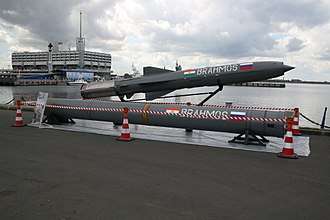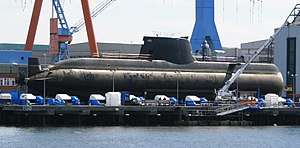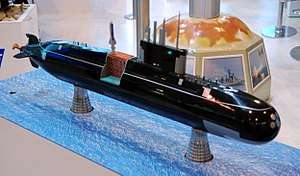Project 75I-class submarine
| Class overview | |
|---|---|
| Name: | Project 75I class (code name) |
| Operators: |
|
| Preceded by: | Kalvari class |
| Cost: | $8 billion[1] |
| Planned: | 6 |
| General characteristics | |
| Type: | Attack submarine |
| Propulsion: | Diesel-electric and AIP |
| Armament: | torpedo tube and VLS cells |
The Project 75I-class submarine is a follow-on of the Project 75 Kalvari-class submarines for the Indian Navy.[1] Under this project, the Indian Navy intends to acquire six diesel-electric submarines, which will also feature advanced Air-independent propulsion (AIP) systems to enable them to stay submerged for longer duration and substantially increase their operational range.[1][2] In October 2014, the project got clearance from Defence Acquisition Council.[3] All six submarines are expected to be constructed in Indian shipyards.[2]
History
In October 2008, the Indian Navy issued a Request for Information (RFI) to a number of foreign shipyards and design firms for construction of a class of advanced diesel-electric submarines. The RFIs were sent to Rosoboronexport, Armaris and HDW, among others.[1][4] Originally the navy intended to purchase two submarines directly from the foreign vendor, with four licence-built at chosen local Indian shipyards in order to save time.[5] Acceptance of Necessity was accorded to the project by the Defence Acquisition Council in August 2010.[6] In December 2014, the new NDA government fast-tracked the bidding process for Project 75I due to mounting concerns over increasing People's Liberation Army Navy activities in the Indian Ocean region.[1][7] and diminishing submarine strength of the Indian navy.[8] Later it was decided to construct all six submarines in Indian shipyards in accordance with the Make in India initiative of the government.

Design
The Project 75I-class submarines will have a vertical launch system (VLS) to enable them to carry multiple Brahmos supersonic cruise missiles, making the submarines fully capable of anti-surface and anti-ship warfare missions. Project 75I submarines will also be armed with torpedoes and will feature advanced stealth capabilities such as a greater ability to suppress noise and acoustic signatures.[3] Submarines will also be outfitted with Air-independent propulsion (AIP) fuel cells which can significantly increase submerged endurance and operational range.[9]
Progress
After years of delays,[5] in October 2014, Project 75l was cleared by the Defence Acquisition Council. ₹53,000 crore (US$7 billion) was allocated for the acquisition of 6 advanced attack submarines.[3] During the bidding process, a high-level committee was set up by the Ministry of Defence (MoD) to inspect and assess the capabilities of different local shipyards to undertake the building of six submarines. The committee shortlisted 5 shipyards which include Hindustan Shipyard, Mazagon Dock, Garden Reach Shipbuilders and Engineers (GRSE), Larsen & Toubro and Pipavav Shipyard. These shipyards are expected to be submitting their bids in partnership with an international shipyard and the Indian navy will choose a design and shipyard which meets its specifications.[10][11]
In July 2017 the RFI (Request for Information) was issued to six submarine builders, and bids were requested to be filed by 15 September 2017, Spain and Japan did not submit responses to RFI and hence seen as opted out of the competition.[12][13] The complete process of selection of a local shipyard and its foreign collaborator could take as much as two years.[12][13][14]
Contenders
| Name | Picture | Origin | Cost | Displacement | Range | Speed | Armament |
|---|---|---|---|---|---|---|---|
| Type 214 submarine |  |
Germany | $330 million | 1,860 tonnes (submerged) | 12,000 miles (19,300 km) surfaced
420 nmi (780 km) @ 8 kt 1,248 nmi (2,311 km) @ 4 kt |
20 knots (37 km/h) submerged | Torpedoes
Harpoon missiles |
| Amur-class submarine |  |
Russia | $450 million | 1,060 tonnes (surfaced)[15] | 350 nmi (650 km) AIP
3,000 nmi (5,600 km) Snorkel |
20 knots (37 km/h) submerged | 16 Torpedoes
10 Brahmos (VLS Cells) |
| A26 submarine | Sweden | 1,930 tonnes | Torpedoes | ||||
| Scorpène-class submarine | France | $450 million | 2,000 tonnes(submerged) | 550 nmi (1,020 km; 630 mi) at 5 kn (9.3 km/h; 5.8 mph) (submerged) | 20 knots (37 km/h; 23 mph) (submerged) | Torpedoes and Exocet Anti-ship missiles. |
See also
External links
- Project 75(I), globalsecurity.org
References
- 1 2 3 4 5 "Made-in-India Submarines for Navy for 53,000 Crores".
- 1 2 Siddiqui, Huma (9 March 2015). "Narendra Modi government shortlists Larsen & Toubro, Pipavav for Rs 60,000 crore submarine contract". The Financial Express.
- 1 2 3 "6 Made-in-India Submarines for Navy for 53,000 Crores".
- ↑ "Project-75A / Project-75I / Project 76".
- 1 2 "Delays force Indian Navy to shake up Project 75I submarine plans".
- ↑ "Procurement of Submarines". Press Information Bureau. 19 December 2011.
- ↑ "Chinese submarine docks in Sri Lanka despite Indian concerns".
- ↑ "A powerful surface navy lacks sub punch".
- ↑ "A look at the Indian Navy's Project 75I tender to #MakeinIndia six diesel-electric submarines".
- ↑ "5 shipyards earmarked for Rs 53,000 crore sub project".
- ↑ "Govt shortlists 5 shipyards for Rs 64,000-cr submarines project". www.hindustantimes.com. Retrieved 2016-01-03.
- 1 2 "India finally kick-starts 'mother of all underwater defence deals' after 10-year delay". economictimes.indiatimes.com. Retrieved 2017-07-24.
- 1 2 Nair-Ghaswalla, Amrita (2017-07-19). "Six in fray for Navy's €8.3-billion advanced submarine project". The Hindu Business Line. Retrieved 2017-09-01.
- ↑ "4 contenders left in fray for India's mega submarine project after Japan, Spain opt out - Times of India". The Times of India. Retrieved 2017-10-20.
- ↑ "Amur 950". www.deagel.com. Retrieved 2015-11-24.
